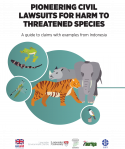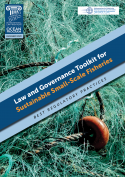
Research Reports
ELI publishes Research Reports available for free download that present the analysis and conclusions of the policy studies ELI undertakes to improve environmental law and policy. These reports contribute to education of the profession and disseminate diverse points of view and opinions to stimulate a robust and creative exchange of ideas. Those publications, which express opinions of the authors and not necessarily those of the Institute, its Board of Directors, or funding organizations, exemplify ELI’s commitment to dialogue with all sectors.
Actions such as illegal wildlife trade, deforestation, mining and pollution are often responsible for huge and diverse harms to the environment—including particular impacts on threatened species. Faced with growing concern about the biodiversity crisis, including reports that at least one million species are at risk of extinction, there are growing demands for social and environmental justice. This includes redoubling efforts to hold responsible parties accountable, and to deter future harmful actions.
Read More >
Cooking in a home kitchen produces air pollutants such as particulate matter and nitrogen dioxide that are linked to respiratory problems, cardiovascular disease, cancer, and other adverse health effects. People who are at greater risk of harm from exposure to these pollutants include children, older adults, people with certain underlying medical conditions, and people who have been socially or economically disadvantaged.
Read More >
Sharks play an essential role in the marine ecosystem. As predators, they help to maintain balance in the food chain, eliminate sick and weak animals, and ensure species diversity; and may play a role in protecting coral reefs.
Read More >
Over the last couple of decades, ocean stewardship efforts have turned to focus on several key approaches, such as the implementation of sustainable fisheries practices, including small-scale fisheries (SSF) co-management. This Toolkit presents a methodology for assessing the reform needs to strengthen SSF governance, along with examples of model regulatory language for the core governance elements.
Read More >
The U.S. Environmental Protection Agency (EPA) is charting a new pathway for the use of citizen science. In recent years, the EPA has played an active role in sharing knowledge of and promoting the use of citizen science at state, tribal, and local environmental agencies. A new agency-wide strategy for citizen science is presently under development. To help inform this strategy, the EPA recognized the need to learn about the uptake of citizen science at state, tribal and local environmental agencies and to determine current best practices.
Read More >